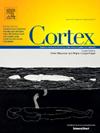空间感觉运动不匹配增加初级体感觉皮层的兴奋性:来自脑电图虚拟现实研究的见解
IF 3.3
2区 心理学
Q1 BEHAVIORAL SCIENCES
引用次数: 0
摘要
在典型情况下,体感觉系统保持稳定的功能。然而,正如对感觉剥夺和经验依赖可塑性的研究所证明的那样,体感觉皮层可以快速重组以响应感觉输入的变化。然而,与异常的感觉运动激活相关的体感可塑性,如在身体-环境相互作用中运动命令和体感反馈模式之间的空间不一致,仍然很少被研究。本研究旨在通过研究在环境相互作用中运动和体感活动之间的相互依赖关系来扩展体感觉皮层功能重组的证据。我们采用了一个创新的虚拟现实(VR)范式来研究空间失配对感觉运动回路的影响,在感觉运动相互作用过程中,空间域分离运动和体感成分。参与者(n = 21)进行了两次实验,每次10分钟,包括VR中的互动任务,他们用右手与虚拟物体互动,并接受一致(在右手)或不一致(在左脚踝)的感官触觉反馈。为了评估体感觉加工的变化,我们测量了任务前后右正中神经刺激引起的脑电图-体感觉诱发电位。我们的研究结果表明,在不一致条件下,体感诱发电位的早期部分(P45)兴奋性增加,而在一致条件下则相反(兴奋性降低)。这些发现可能表明初级体感皮层(SI)的功能变化,可能是由任务期间来自不相关身体部位的神经活动的时间耦合驱动的。然而,注意机制也可能有助于这种效果。虽然是初步的,但这些结果为研究在主动相互作用中运动和体感觉皮层之间重复关联活动驱动的感觉运动适应开辟了新的途径。本文章由计算机程序翻译,如有差异,请以英文原文为准。
Spatial sensorimotor mismatch increases the excitability of the primary somatosensory cortex: Insight from an EEG-virtual reality study
Under typical conditions, the somatosensory system maintains stable functionality. However, the somatosensory cortex can rapidly reorganize in response to sensory input changes, as demonstrated by studies on sensory deprivation and experience-dependent plasticity. Nevertheless, somatosensory plasticity related to unusual sensorimotor activation, such as spatial incongruence between motor commands and somatosensory feedback patterns during body–environment interactions, remains less investigated. This study aims to extend the evidence for functional reorganization of the somatosensory cortex by investigating the interdependency between motor and somatosensory activity during environmental interactions. We employed an innovative virtual reality (VR) paradigm to investigate the effects of spatial mismatch in sensorimotor loops, dissociating motor and somatosensory components in thespatial domain during sensorimotor interactions. Participants (n = 21) performed two experimental sessions composed of 10 minutes each, involving an interaction task in VR, whereby they interacted with a virtual object with their right hand and received either congruent (on the right hand) or incongruent (on their left ankle) sensory tactile feedback. To assess changes in somatosensory processing, we measured EEG-somatosensory evoked potentials elicited by right median nerve stimulation before and after the task. Our results evidenced increased excitability in the early component of somatosensory evoked potentials (P45) following the incongruent condition, with an opposite trend (decrease of excitability) on the congruent condition. These findings may suggest functional changes in the primary somatosensory cortex (SI), likely driven by the temporal coupling of neural activity from unrelated body parts during the task. However, attentional mechanisms may also contribute to this effect. While preliminary, these results open new avenues for investigating sensorimotor adaptation driven by repeated associative activity between motor and somatosensory cortices during active interactions.
求助全文
通过发布文献求助,成功后即可免费获取论文全文。
去求助
来源期刊

Cortex
医学-行为科学
CiteScore
7.00
自引率
5.60%
发文量
250
审稿时长
74 days
期刊介绍:
CORTEX is an international journal devoted to the study of cognition and of the relationship between the nervous system and mental processes, particularly as these are reflected in the behaviour of patients with acquired brain lesions, normal volunteers, children with typical and atypical development, and in the activation of brain regions and systems as recorded by functional neuroimaging techniques. It was founded in 1964 by Ennio De Renzi.
 求助内容:
求助内容: 应助结果提醒方式:
应助结果提醒方式:


